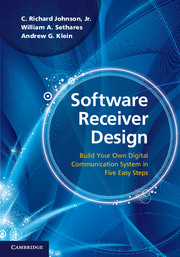Book contents
- Frontmatter
- To the Instructor …
- Contents
- Dedication
- Step 1 The Big Picture
- Step 2 The Basic Components
- Step 3 The Idealized System
- Step 4 The Adaptive Components
- 10 Carrier Recovery
- 11 Pulse Shaping and Receive Filtering
- 12 Timing Recovery
- 13 Linear Equalization
- 14 Coding
- Step 5 Putting It All Together
- Appendices
- Index
11 - Pulse Shaping and Receive Filtering
from Step 4 - The Adaptive Components
Published online by Cambridge University Press: 05 June 2012
- Frontmatter
- To the Instructor …
- Contents
- Dedication
- Step 1 The Big Picture
- Step 2 The Basic Components
- Step 3 The Idealized System
- Step 4 The Adaptive Components
- 10 Carrier Recovery
- 11 Pulse Shaping and Receive Filtering
- 12 Timing Recovery
- 13 Linear Equalization
- 14 Coding
- Step 5 Putting It All Together
- Appendices
- Index
Summary
When the message is digital, it must be converted into an analog signal in order to be transmitted. This conversion is done by the “transmit” or “pulse-shaping” filter, which changes each symbol in the digital message into a suitable analog pulse. After transmission, the “receive” filter assists in recapturing the digital values from the received pulses. This chapter focuses on the design and specification of these filters.
The symbols in the digital input sequence w(kT) are chosen from a finite set of values. For instance, they might be binary ±1, or they may take values from a larger set such as the four-level alphabet ±1, ±3. As suggested in Figure 11.1, the sequence w(kT) is indexed by the integer k, and the data rate is one symbol every T seconds. Similarly, the output m(kT) assumes values from the same alphabet as w(kT) and at the same rate. Thus the message is fully specified at times kT for all integers k. But what happens between these times, between kT and (k + 1)T? The analog modulation of Chapter 5 operates continuously, and some values must be used to fill in the digital input between the samples. This is the job of the pulse-shaping filter: to turn a discrete-time sequence into an analog signal.
Each symbol w(kT) of the message initiates an analog pulse that is scaled by the value of the signal.
- Type
- Chapter
- Information
- Software Receiver DesignBuild your Own Digital Communication System in Five Easy Steps, pp. 226 - 249Publisher: Cambridge University PressPrint publication year: 2011



